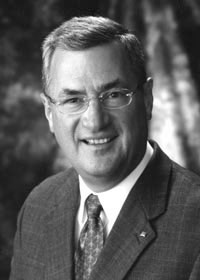Dr. Edmund O. Schweitzer III
Founder and President
Schweitzer Engineering Labs
BSEE 1968, MSEE 1971

We were told that ours was the last class to be taught vacuum tubes. We solved load-line problems on a slate board with the V-I characteristics of the 6SN7 tube.
Ed Schweitzer is credited with creating the first digital protective relay in 1982, revolutionizing the protection industry. He developed a digital relay as his PhD project while at Washington State University in Pullman, Washington, and that project led to the manufacturing of the world’s first all-digital protective relay. He continued his research in digital protective relaying while serving on the electrical engineering faculties of Ohio University and Washington State University. The research covered both theoretical and practical aspects, and demonstrated the feasibility and practicality of digital techniques for protecting electric power apparatus and systems.
Schweitzer started Schweitzer Engineering Labs in the basement of his Pullman home with $2,000 and incorporated the company in 1982. In 1984, SEL shipped its first products to Otter Tail Power Company in Fergus Falls, Minnesota.
Building on the theme of innovation in the electric utility industry that his father and grandfather began (Edmund O Schweitzer and his partner developed the first reliable high-voltage fuse; Edmund O. Schweitzer, Jr. researched and invented several different line-powered fault indicating devices and founded E.O. Schweitzer Manufacturing Company), Schweitzer founded SEL for the purpose of making the transmission of electric power safer, more reliable, and more economical.
In 1985, SEL built its first building, employed eleven people, and produced sales of $0.5 million. Today, SEL is employee-owned, has more than 800 employees, and had sales exceeding $100 million in 2002. The company serves the electric power industry worldwide through its Pullman headquarters, 25 domestic offices, and 17 international locations in Europe, the United Kingdom, China, Australia, New Zealand, South Africa, Brazil, Bolivia, Canada, and Mexico. Today, SEL sells to virtually every electric utility in the United States and has customers in 90 countries around the world.
Schweitzer’s interest in the field of electrical engineering began when he was a student at Purdue. He loved discovering electromagnetics and solving boundary-value problems. Looking back, it’s difficult to believe that in addition to learning Fortran and keypunching decks of cards for computers like the IBM-7094, he enjoyed playing with a rotating-drum computer, the RPC-4000. "Programming that was not unlike the early days of microprocessors 15 years later," he says.
Schweitzer fondly remembers many of his Purdue professors, including Walter L. Weeks, Chin-Lin Chen, David B. Miller (MSEE advisor), and Benjamin J. Leon, and is grateful for what they taught him.
He recalls that during his time on the campus, "We were told that ours was the last class to be taught vacuum tubes. We solved load-line problems on a slate board with the V-I characteristics of the 6SN7 tube."
He also remembers an occurrence that was of great interest to him during his freshman year, 1965, the first major electrical blackout.
Carrying on the family tradition, Schweitzer’s daughter, Stephanie, is an economist with E.O. Schweitzer Manufacturing Company in Chicago and his son, Eddie, is a mechanical engineer with Schweitzer Engineering Laboratories in Pullman. Another son, Paul serves with the U.S. Navy and has just returned from the Persian Gulf.
Schweitzer continues to lecture at universities throughout the country and is a visiting professor at Mexico’s Universidad Autonoma de Nuevo Leon in Monterrey. He considers himself both a teacher and a working engineer. "Selling is teaching," is a famous quote of his that is used in the company. He believes that if you teach your customers how to use your products to their fullest, it’s the easiest way to sell them.
"I would tell students to focus on the fundamentals when you’re in school," Schwietzer says. "That’s what schools like Purdue are good at teaching. Insist on real labs with real equipment. Don’t settle for simulations."
